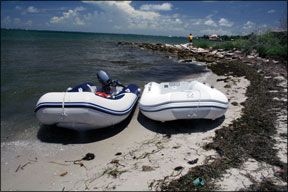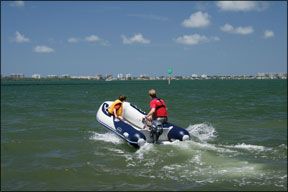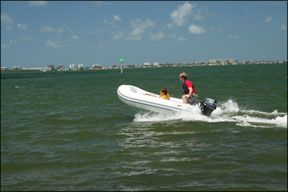Remember when Forrest Gumps friend Bubba sounded all of the different ways you can prepare shrimp? “Deys shrimp-kabobs, shrimp Creole, shrimp gumbo, pan fried, deep fried, stir-fried…” It went on and on-reminding us of the list of inflatable boats on the market today: Deys soft-stern dinghies, roll-up boats, sport boats, wood-floor boats, high-pressure floor boats, rigid inflatable boats, high-pressure V-hull boats, and so on. Its head spinning.
For this comparison, we examined two boats featuring recent innovations in hull construction: West Marines HP-V 350, with a high-pressure V-shaped bottom; and Zodiacs FR340 Fastroller with Acti-V bottom, featuring a high-pressure floor with an inflatable V-shaped keel.

Heres what the companies have to say about their boats. West Marine: “Unlike regular high-pressure floor boats, these do not have a flat floor or inflatable keel … Instead, two sections of high-pressure fabric are joined into a V-section that, when inflated, creates the deep-V hull shape.”
And Zodiac: The FR340 has “a high-pressure air floor and keel that are inflated from one valve. Its award-winning Acti-V hull provides the rigidity needed for best performance. The keel, higher and thinner, forms a deep-V, similar to the shape of the semi-rigid boats.”
Both boats purport to have “deep-V” bottoms. Thats a stretch. A deep-V keel is typically defined as 24 degrees or deeper, intended to deliver a softer ride in chop. The Zodiacs deadrise measures 12 degrees, and the West Marine boat is about the same. They are not flat, but in our book, they are not deep-V hulls.
Apart from the West Marine HP-V 350s larger overall dimensions, the chief difference between the two boats is in the floor-keel design. The entire bottom of the West boat is shaped like a “V” and permanently connected to its tubes. Only the keel of the Zodiac is V-shaped. The boats integral air floor/keel are removable.
The West Marine is longer than the Zodiac by a half-foot and narrower by 4 inches. The Zodiac weighs 14 pounds less than the West Marine boat. Both are constructed of PVC and carry five-year warranties (typical of PVC hulls). The West Marine boat holds a substantial edge in price: $1,700 versus $2,299 for the Zodiac.
Both the HP-V 350 and the FR340 Fastroller can handle up to 15-horsepower outboards. The West Marine boat has a greater maximum load: 1,984 pounds compared to Zodiacs 1,653 pounds.
Larger tubes generally mean a drier boat, and the Zodiac tubes are 2 inches larger in diameter than those on the West Marine, but the latters tube are higher at the bow, which helps deflect spray.
How We Tested
Testing was done in two stages. Both boats were inflated and evaluated at our shop. PS testers examined grab and carrying handles, oars, lifting rings, seating and storage, drain-plug design, and towing eyes. We also took a look at the transom design and construction as well as the bottom designs.
On-the-water testing took place in moderate conditions, with 10- to 12-knot breezes and a slight chop, although there was enough wake from boat traffic to get an idea of their performance in rougher conditions. Our test motor was a 9.9-horsepower Yamaha four-stroke, which we reviewed in the October 2008 issue. Testers checked the following performance points: quickness to plane, dryness and comfort, and high- and low-speed handling (also in reverse). Finally, we rowed each boat. Ratings appear in the Value Guide above.

Both boats are a pain to inflate using the manufacturer-provided manual air pumps (particularly the Zodiac), in our opinion. If you are going to frequently inflate and deflate the boat, wed suggest investing in a regulated, high-pressure pump with pressure gauge.
Zodiac FR340 Fastroller
The Zodiacs deck details scored a mixed review. One bonus is the flat high-pressure floor, which makes it easier to keep your footing. Water collects beneath this floor/keel, keeping feet and gear drier.
For dry storage aboard, the Zodiac has a plastic container in a compartment in the bow. Theres also a vinyl bow bag, which a more intelligent life form should be able to install. (Testers got no help from the manual here.)
Four handholds attach to straps on the tube tops. They can slide fore and aft, but testers found it difficult to adjust them. The boats bench seat can be set in one of two positions, even when the boat is inflated. This is convenient, though we wonder how the small plastic clips that secure the seats will hold up.
The Zodiac has the advantage when it comes to oars and oarlocks. The oars can be feathered, and they slide inboard and outboard, giving the rower better control of the boat. The West Marine oars do not feather and cannot be moved inboard or outboard.
The Zodiac has a screened scupper with a small lever that opens and closes the screen.
With our 9.9-horsepower Yamaha, the Zodiac topped out at 17 knots, which is very fast for such a small boat. The boat was a bit squirrelly at high speeds-as many inflatable boats are.
Once testers accelerated, the bow rose high enough to cut off the drivers view ahead for a few seconds. He had to shift his weight forward to help the boat plane. This also is not unusual for a boat of this size. The boat performed fine at slow speeds and in reverse.

The Zodiac delivered a rougher, wetter ride than the West Marine boat, in part because it is smaller.
Bottom line: Pluses include a smart oar and oarlock design, a nifty forward storage compartment, and an easy-to-use drain. Ride quality was not as good as the West Marine boat. Except for the wimpier rubrail and some minor details, construction quality was superior. The removable floor-keel construction makes sense, since rips or tears in the keel or floor are easier to deal with.
West Marine HP-V 350
Because the West Marine HP-V 350s deck is integral to the V-shaped hull it is slanted. This makes it more difficult to keep your balance when standing on deck and offers no floor to separate feet and gear from any water that might collect in the boat. The setup is, however, easier to bail and keep clean of dirt and mildew. It also offers more interior volume.
The West Marines bow sweeps up higher than the Zodiacs, offering better spray protection, and its rubrail is beefier than the Zodiacs. The West Marine boat has more handholds, but the pilot handhold was a little too far aft for our tall tester.
The West Marines seat must be installed when the boat is partially inflated, but the attachment seems more solid than the Zodiacs. The West Marines drain is a simpler setup: a screened hole and a plug.
The West Marine boat has 12 handholds that passengers can grab while underway. There are also two carrying handles in the stern quarters on the outboard sides of the tubes, plus one at the bow, below the rubrail.
The West Marine reached a top speed of 15 knots. The keel seemed to bite better than the Zodiac, allowing it to deliver a smoother ride. The boat also tracked and turned well. It rode well at slow speeds and in reverse, too. Testers found the ride aboard the West Marine to be drier than the ride on the Zodiac.
Most notably, the bow rise upon acceleration from a dead stop was not as severe as the Zodiacs.
Bottom line: The boat delivers a smooth, dry ride and tracks very well. The V-floor has a balance of pros and cons. A thick, abrasion-resistant fabric protects the hull bottom, but if it or the floor is punctured, repair can be expensive or impractical.
Conclusion
While these boats perform better than older roll-up designs, this performance may not be worth the extra expenses or trade-offs. Another knock is that both boats are made of PVC material. Hypalon hulls are heavier, but they generally hold up better in the long term, particularly in warmer climates.
Before shelling out the money for an inflatable, PS encourages buyers to also consider the rigid inflatable boats (July and October 2008 issues) and the high-pressure floor models (May 1, 2004) weve tested.
For a rigid-transom RIB, we recommended the Zodiac YL 310, the Caribe L10, and the Achilles HB 315 DX. For RIBs with folding transoms, PS picked the Walker Bay Genesis Light 310 FTD. In a test of seven small roll-up boats with inflatable decks and keels, the Zodiac Cadet 310FR ACTI-V was the favorite.
In this shootout, the West Marine HP-V 350 stands out as the Budget Buy, with its superior ride, multiple handholds, and beefy rubrail. Its heavier than the Zodiac, but its also $600 less expensive.
The Zodiac gives a smoother ride than similar V-bottom rollups. Its high-pressure floor/keel design makes sense, and its overall finish quality is better than the West Marine. It is recommended for those who need a lightweight, but large roll-up for temperate climates.








































I have had very poor luck with the quality of the West Marine inflatable and the lack of support from the company. My one year old boat no longer holds air in 2 of three chambers, and the West Marine warranty is mostly fiction. Poor build quality and very poor customer support.
Buyer beware.